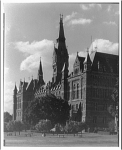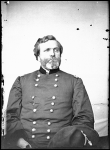Today in History: July 31
Patrick Francis Healy Inaugurated as President of Georgetown University

Patrick Francis Healy,
Photographic print.
Prints & Photographs Online Catalog

Architectural drawing for the Healy Building,
Georgetown University, Washington, D.C.,
Perspective rendering,
J. L. Smithmeyer & Co., architect,
1875.
Prints & Photographs Online Catalog
Patrick Francis Healy, SJ, was inaugurated as president of Georgetown University on July 31, 1874. The Reverend Father John Carroll (later Archbishop Carroll), who was neither president of Georgetown University, nor a faculty member, founded the university in 1789. Healy is considered Georgetown's "second founder."
One of the first African Americans to receive a PhD and the first to head a predominantly white university, Healy was born in Jones County, Georgia, to Michael Morris Healy, an Irish-immigrant planter, and Mary Eliza, a mulatto slave. Patrick was one of ten children. The boys were not allowed to attend schools in Georgia as they were considered slaves by state law so Michael Healy sent his four older sons North where they would become free and able to receive an education. They first attended a Quaker school in Flushing, New York, before they enrolled in the College of the Holy Cross in Worcester, Massachusetts.
After graduating, Patrick Healy entered the Jesuits in 1850. He took his vows in 1852 and became a teacher and prefect at St. Joseph's College in Philadelphia. In 1853 he returned to Holy Cross as a teacher and in 1858 he was assigned to study philosophy and theology at Georgetown University before receiving orders to go to Rome for further ecclesiastical studies. The Roman winter was hard on his health so he was sent to the Catholic University of Louvain (Leuven) in Belgium where he received a doctorate in philosophy in 1865. Healy became a priest in 1864. In 1866, he returned to teach philosophy at Georgetown, then a preparatory academy and small college.
Healy took his final vows as a Jesuit in 1867 and was named prefect of studies (dean) in 1868 and then vice president. The university's board of directors voted him acting president in 1873 upon the unexpected death of the president, the Reverend John Early. The following year Healy was confirmed as president.

Healy Hall,
Georgetown University,
Washington, D.C.,
Theodor Horydczak, photographer,
October 1948.
Washington as It Was: Photographs by Theodor Horydczak, 1923-1959
The unique Flemish Renaissance structure pictured above, a distinctive feature of the Washington, D.C., skyline, was a product of the Healy administration.
In the antebellum period, Georgetown attracted mainly Southern students: four-fifths of its alumni joined the Confederacy. After the war, however, students came in far greater numbers from the Northeast. The university's colors — blue and gray — were selected to symbolize the healing and reuniting of the country.
Healy initiated Georgetown's transformation from a small school to a modern university. In the post-Civil War years, he modernized the curriculum and his reforms included a new emphasis on science, expanding and upgrading the law and medical schools, and centralizing the university’s libraries. Healy also founded the Alumni Association and oversaw major construction projects. Due to ill health, his doctor advised him to retire; he did so in 1882. Patrick Francis Healy died in 1910.

The Aqueduct Bridge and Georgetown from Virginia,
William Morris Smith, photographer,
between 1860 and 1865.
Selected Civil War Photographs
Learn more about the role religion and religious education played in the development of the United States from American Memory collections.
- Early Virginia Religious Petitions presents images of 423 petitions submitted to the Virginia legislature between 1774 and 1802 from more than eighty counties and cities on topics such as topics as the historic debate over the separation of church and state, the rights of dissenters such as Quakers and Baptists, and the sale and division of property in the established church.
- Sunday School Books: Shaping the Values of Youth in Nineteenth-Century America presents 163 Sunday school books published in America between 1815 and 1865 and documents the culture of religious instruction of youth during the Antebellum era.
- The Church in the Southern Black Community, 1780-1925 traces how Southern African Americans experienced and transformed Protestant Christianity into the central institution of community life.
- View the online exhibition Religion and the Founding of the American Republic for more discussion about the role of religion.
- Search on Jesuit in The Nineteenth Century in Print: Periodicals to view forty-five articles on Jesuits in North America and abroad, Jesuit missions, and more.
- View more images of Georgetown University and pictures of Washington, D.C., as seen from the campus. Search across the American Memory collections on Georgetown, as well as in the Prints & Photographs Online Catalog.
- Search the Today in History Archive on college or university to find features on American colleges and universities including Columbia, Harvard, Howard, and Vassar.
Rock of Chickamauga

Portrait of Maj. Gen. George H. Thomas,
officer of the Federal Army,
Brady National Photographic Art Gallery,
between 1860 and 1865.
Selected Civil War Photographs
On July 31, 1816, George H. Thomas was born in Southampton County, Virginia. An 1840 graduate of West Point, Thomas served in the Mexican-American War (1846-48) and returned to teach at West Point in 1851. When the Civil War began, he remained loyal to the Union, causing his family in Virginia to sever their ties with him.
Thomas became known as the "Rock of Chickamauga" for his 1863 defense of that creek in northwestern Georgia. He also played a key role in Union General William T. Sherman's siege of Atlanta the following year.
In late 1864, Thomas clashed twice with Confederate General John B. Hood in Tennessee—in November at Spring Hill and Franklin, and in December at Nashville. Thomas' rout of Hood at Nashville, the most decisive victory of the war, earned him another nickname—the "Sledge of Nashville."

Nashville, Tenn, Railroad yard and depot with locomotives; the Capitol in distance,
George N. Barnard, photographer,
1864.
Selected Civil War Photographs

Nashville, Tenn. Federal outer line,
George N. Barnard, photographer,
December 16, 1864.
Selected Civil War Photographs
Learn more about the Civil War in American Memory collections:
- Search the collection Touring Turn-of-the-Century America: Photographs from the Detroit Publishing Company, 1880-1920 on the term Chickamauga for images associated with that battle.
- Use the Timeline of the Civil War, a special presentation of the Selected Civil War Photographs, to follow a year-by-year overview of the conflict. Search the collection to find more photographs of people and battles.
- Locate recollections of participants in the war by a searching on Civil War in American Life Histories: Manuscripts from the Federal Writers' Project, 1936-1940. Narrow the selection by adding a major battle or topic to the search, for example, Civil War AND Gettysburg.
- Search the collection Civil War Maps on the names of locations or battlefields to find maps of sites of the conflict.
- Visit Primary Documents in American History: Civil War and Reconstruction, 1860-1877 to view documents such as the Emancipation Proclamation.
- Search the Today in History Archive on Civil War to locate more features, such as Lee's surrender to Grant (April 9), the three days of the Battle of Gettysburg (July 1, July 2, and July 3), and the First Battle of Bull Run (July 21).